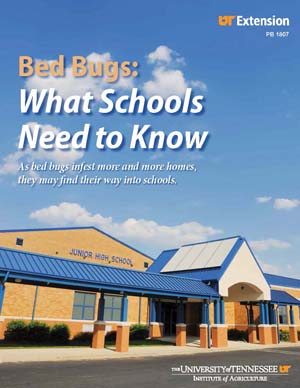Bed Bugs: What Schools Need to Know
- Sample Letter: Bed Bugs Found — Parent Notification
- Chinches de Cama Encontrados en la Escuela de Padres: Carta de Notificacion (Spanish translation credit: Dr. Juan Luis Jurat-Fuentes, UT E&PP and Roberto Brenes, UT FWF)
- Sample Letter: Bed Bug Plan — Parent Notification
- Plano de Chinches de Cama: Carta de Notificacion para Padres (Spanish translation credit: Dr. Juan Luis Jurat-Fuentes, UT E&PP and Drs. Armando Ulloa and Abelardo Moncayo, TDH)
Should We be Concerned about Bed Bugs in Schools? (EPP Info #778, “Pests and Pesticides in Child-serving Facilitities:” An IPM Newsletter, December 2010, Volume 4, Issue 2)
Other Articles on Bed Bugs (EPP Info #778, “Pests and Pesticides in Child-serving Facilitities:” An IPM Newsletter)

Bed Bugs in Schools — National Perspective
- Bed Bug Fact Sheets
- Bed Bugs Go to School
- Bed Bugs: What Schools Need to Know
- Michigan Manual for the Prevention and Control of Bed Bugs (Section on schools & day care facilities)
- NYC Department of Education (Bed bug kit with sample letter at end)
- Integrated Pest Management for Schools and Day Cares (North Carolina State University)
- School IPM Action Plan for Bed Bugs
- Wayne Walker, University of Florida, Housing and Residence Education
- Non-Chemical Bed Bug Management
- Bed Bug Action Plan for Schools
Precautionary Statement
To protect people and the environment, pesticides should be used safely. This is everyone’s responsibility, especially the user. Read and follow label directions carefully before you buy, mix, apply, store or dispose of a pesticide. According to laws regulating pesticides, they must be used only as directed by the label and registered for use in your state.
Disclaimer
This publication contains pesticide recommendations that are subject to change at any time. The recommendations in this publication are provided only as a guide. It is always the pesticide applicator’s responsibility, by law, to read and follow all current label directions for the specific pesticide being used. The label always takes precedence over the recommendations found in this publication.
Use of trade or brand names in this publication is for clarity and information; it does not imply approval of the product to the exclusion of others that may be of similar, suitable composition, nor does it guarantee or warrant the standard of the product. The author(s), the University of Tennessee Institute of Agriculture and University of Tennessee Extension assume no liability resulting from the use of these recommendations.